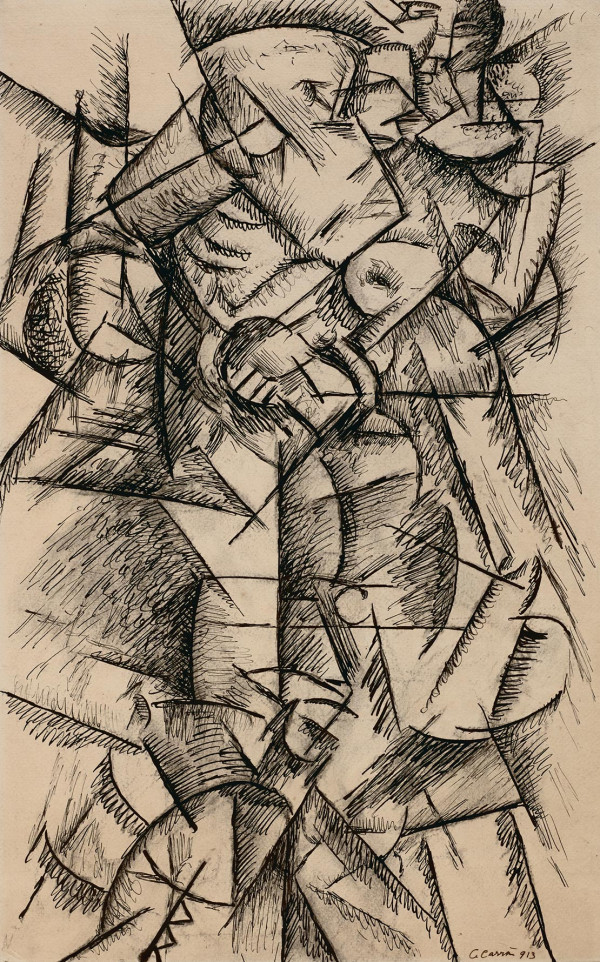
Introduction
Futurism was characterised by its fervent celebration of the dynamism, speed and energy of the modern age. At the core of Futurist art lay a profound preoccupation with the concept of movement. Artists sought to capture the essence of motion, whether in the bustling streets of the city, the speed of machines, or the chaos of war. In this article, we will explore how Futurist artists, through their innovative techniques and unique perspectives, conveyed the concept of movement in their groundbreaking works.
The Quest for Dynamism
Futurist artists were pioneers in creating dynamic compositions that conveyed movement. They abandoned traditional linear perspectives and instead utilised fractured forms and sharp angles to infuse their works with a sense of action and motion. Giacomo Balla’s Hand of the Violinist is a prime example, as it captures the fluidity of a moving hand playing the violin through a series of overlapping and fragmented shapes.
Such imagery was partly inspired by the chronophotography of figures such as Eadweard Muybridge and Etienne-Jules Marey who aimed to record and represent time. The Futurists’ desire to capture the essence of modern life, with its constant change and movement, created a natural affinity with chronophotographic principles and experimental techniques which contributed to the dynamic and forward-looking character of the Futurist movement in the early 20th century.
Another concept deployed by Futurist artists was the concept of simultaneity, portraying multiple viewpoints of an object or scene in a single image. This technique aimed to replicate the way the human eye perceives motion and change over time. Carlo Carrà’s Boxer embodies this idea by presenting a figure in motion from various angles simultaneously, creating a sense of fluidity.

Futurist artists incorporated speed lines and motion trails into their works. These elements conveyed the blurring of objects in motion, as seen in Umberto Boccioni’s Dynamism of a Cyclist, where lines are used to convey a sense of rapid movement.
Futurism shared some similarities with Cubism, particularly in its exploration of fragmented forms. However, while Cubism aimed to depict multiple facets of an object simultaneously, Futurism focused on the portrayal of motion and change. This distinction is evident in Gino Severini’s Dancer, which combines Cubist fragmentation with a sense of rhythm and motion.

Ballerina + mare], 1913
Futurist artists were captivated by the hustle and bustle of urban environments. They portrayed the movement of people, vehicles and machinery in the rapidly evolving cities of the early 20th century. Severini’s Boulevard and Carrà’s Leaving the Theatre, are prime examples that capture the vibrant energy of city life.

Futurism celebrated the technological advancements of the era, particularly the advent of automobiles, aeroplanes and trains. Works like Boccioni’s States of Mind: The Farewells and Sironi’s Urban Landscape, Aeroplane and Seated Woman convey the exhilarating speed and power of these machines.
The Futurists’ fascination with movement extended to the chaos and violence of war. Artists such as Severini and Carrà depicted the rapid movements of soldiers and the destructive force of artillery in their war-themed works.

scoppio di un obice), 1914
The concept of movement was a central and defining element of Futurist art. Through innovative techniques and a deep engagement with the dynamism of the modern world, Futurist artists created a visual language that celebrated the exhilarating speed, energy, and motion of their time. Their pioneering efforts not only influenced subsequent artistic movements but also continue to inspire contemporary artists, reminding us of the timeless fascination with the concept of movement in art and life itself. Futurism’s legacy is one that challenges us to see the world in a perpetual state of flux, in constant motion and transformation.